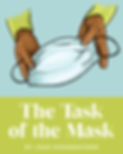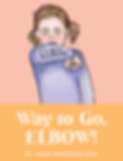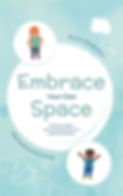
THE TASK OF
THE MASK
A MESSAGE TO GROWN-UPS:
U.S. health officials are recommending that people wear face masks in public to reduce the spread of the coronavirus, especially when physical distancing is difficult to maintain. Although this is a reasonable precaution, for many young children this new normal will look strange and might even feel scary.
The book, The Task of the Mask, was written to help allay young children’s worries, so they can be better prepared for this situation. The language in the story is lyrical and upbeat. And its message is clear: the purpose of the face mask is to collect nose and mouth germs so they don’t spread to other people. It also describes the difference between a face mask and an eye mask, which is something many young children use in pretend play. Most importantly, at the end of the story it reminds children that although the face mask might look different, the person behind the mask is always the same!
HELPFUL TIPS:
-
If possible, read the story before going with your child into public venues, where people will be wearing face masks.
-
Keep this book available for children to review. They may want to hear the story over and over again. This is a sign that they are working to understand and make meaning of the changes they are experiencing.
-
Engage your child in conversation as you read the story to them; listen carefully to their questions and respond simply, honestly, and in a matter-of-fact manner.
-
Cut-out the paper face mask template in the back of the book and invite your child to decorate it. It may be helpful to make a stencil of the mask so this activity can be easily repeated.
-
Encourage your child to make face masks for a favorite doll or stuffed animal.
-
If available, add a real face mask to your child’s pretend play toys.
WAY TO GO,
ELBOW!
A MESSAGE TO GROWN-UPS:
Although kids and germs go hand-in-hand, it can be difficult for children to understand why it’s necessary to take certain precautions against spreading germs – which they can’t even see. Most children forget to cover their nose and mouth when they sneeze and cough, or they rely on their hands to cover their face. But we know that using the bend of the arm is a more effective strategy to minimize the spread of germs since we don’t use that part of our anatomy to touch things. With the recent introduction of the novel coronavirus, it is imperative that we teach children healthy hygiene practices that limit the spread of germs.
Way to Go Elbow, was written with this in mind. This simple and informative story explains that each person’s elbow has a very important job - to catch their own sneezes and coughs. The story is fun and educational and its lyrical dialogue and upbeat message will appeal to young children. The end of the story reinforces children learning by likening a job of an elbow to the task performed by a superhero. This book is the perfect complement to any school curriculum that is proactively teaching children healthy hygiene habits. The more we educate our children and model healthy behaviors that reduce the spread of germs, the better equipped they’ll be to make these habits their own.
HELPFUL TIPS:
-
Have children follow the instructions in the book as you narrate the story.
-
Keep in mind: unlike hand-washing, which occurs many times throughout the day, sneezing and coughing happen less frequently. This is why children often forget to use their elbow.
-
An “Elbow Cape” is a fun way to remind children to use their elbow to catch their cough or sneeze.
-
Make an “Elbow Cape” that children can wear on their elbow. Cape template and instructions can be found at the end of the book.


EMBRACE YOUR
OWN SPACE
A MESSAGE TO GROWN-UPS:
Respecting personal space, the comfortable physical distance
between two people, has always been a difficult concept to convey
to children. The necessity of maintaining physical distance to
reduce the spread of germs makes teaching this concept even more
important. This book, Embrace Your Own Space, uses the symbol
of a bubble to help define the invisible space around each of us,
which creates an appropriate and healthy physical boundary.
ACTIVITIES FOR CHILDREN:
As you read this book, there are several opportunities for children to practice establishing their own “Bubble of Space” with their classmates, friends and siblings.
-
Outstretched Arms: Have children stretch their arms out wide and look from side to side to visualize their personal space. If they can stand in a cluster or in a line without touching anyone, they’re doing it correctly!
-
The Environment: Point out squares in the sidewalk or sections of carpet tiles, to help children find a “Bubble of Space” when seated or standing in line.
-
Common Props: Take out a small hula hoop, gym ring, a piece of string or draw a chalk circle on the ground to provide a visual representation of a “Bubble of Space.” Have children step inside these boundaries to inhabit their personal “Bubble of Space.” Once they’ve practiced using props, remove the boundaries and encourage the children to maintain their “Bubble of Space.” Bring the props back and check for accuracy.
-
Puppets: Demonstrate with hand puppets the concept of being “too close” to one another, and how a personal “Bubble of Space” is more comfortable and safe.
Helpful Reminders:
-
Continue to practice these distancing skills on a regular basis to reinforce the concept.
-
Remind children that physical distancing is used to protect both them and others.